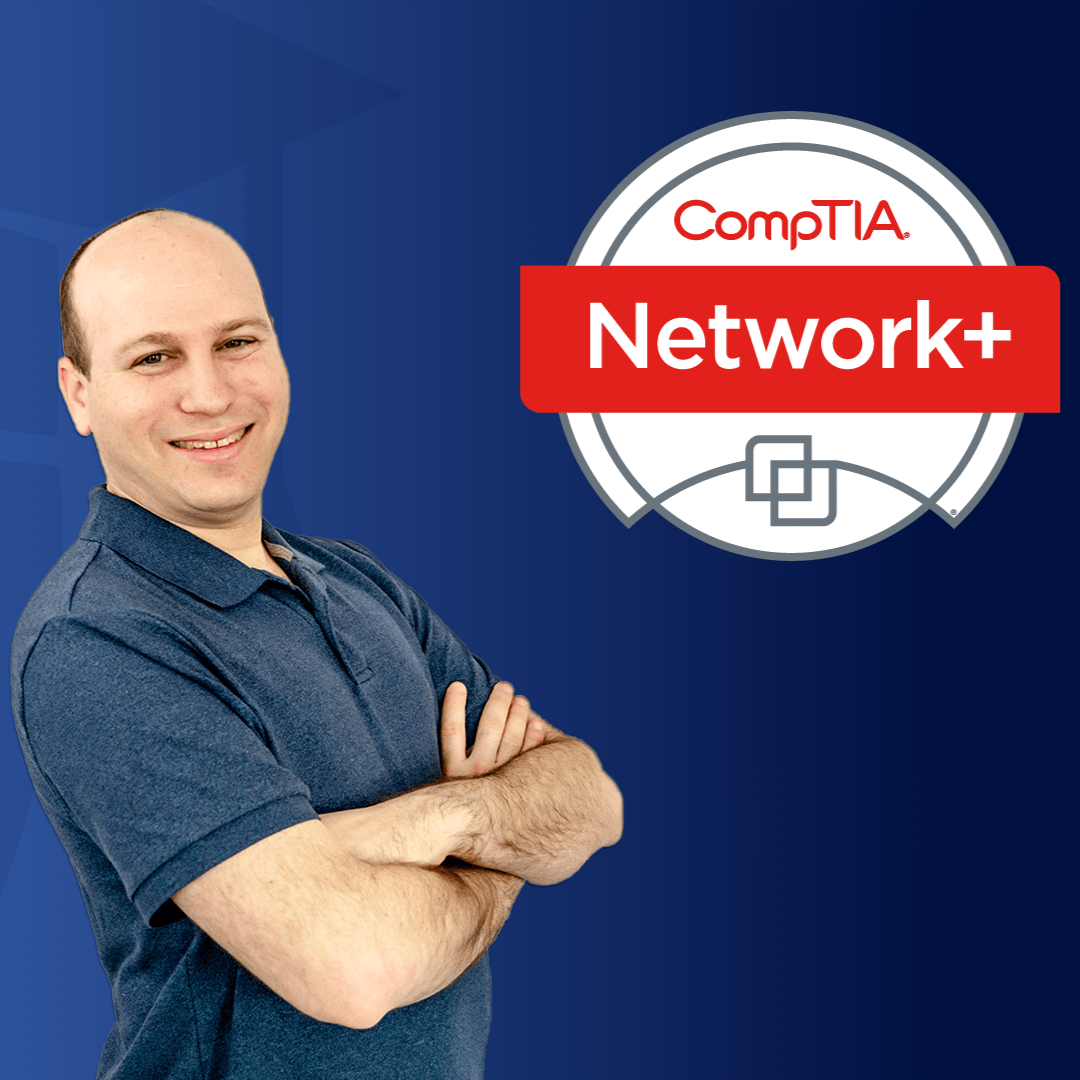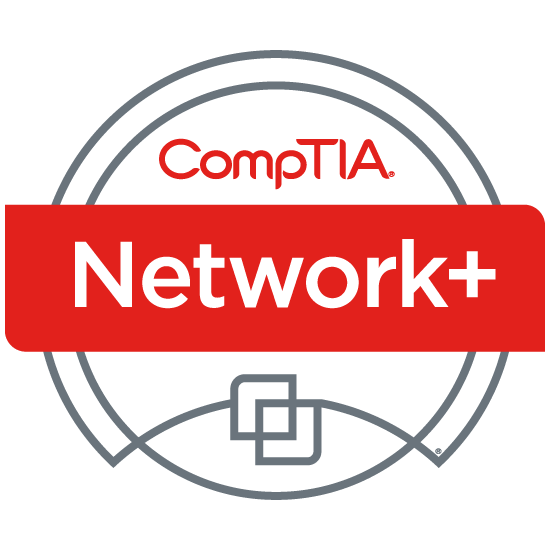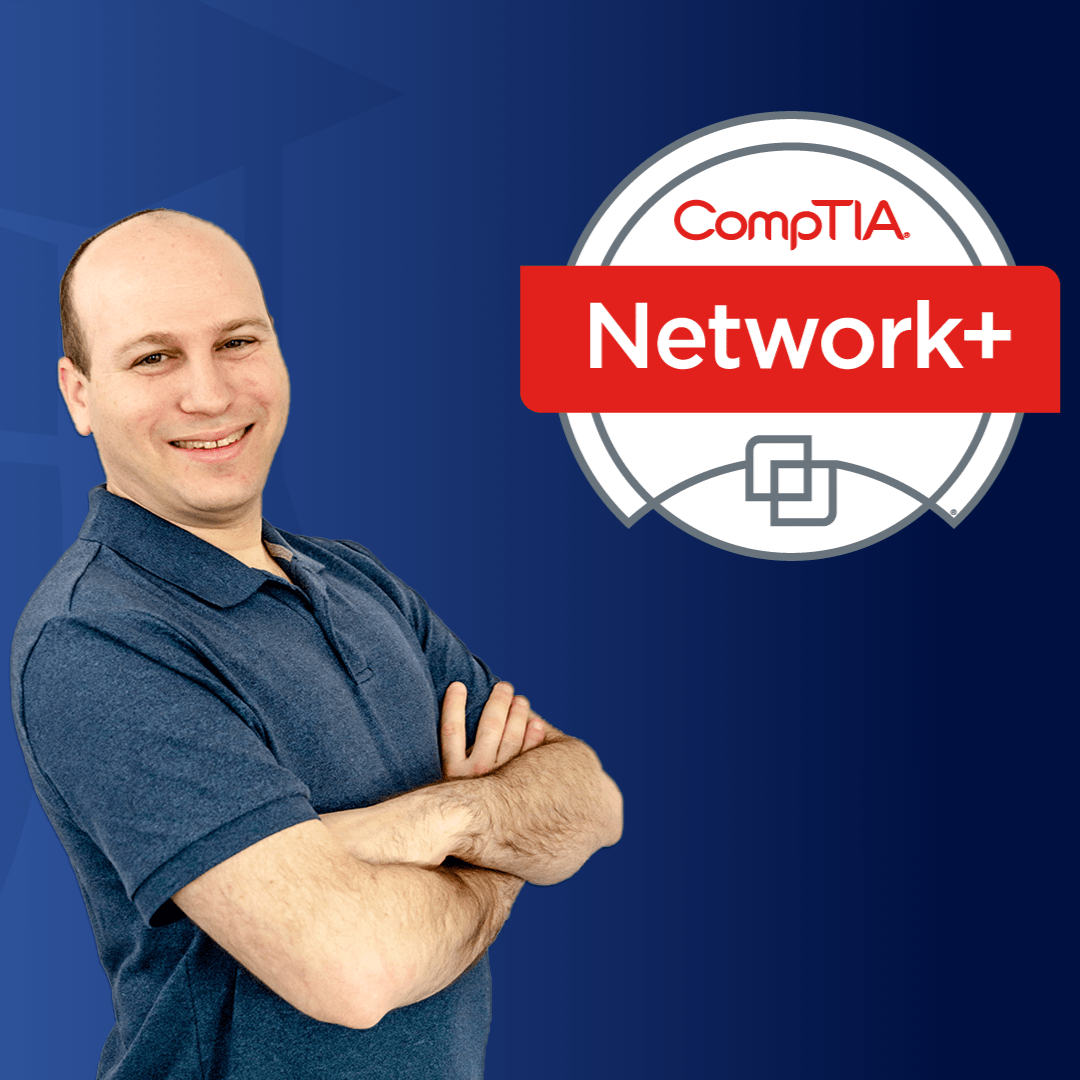Network+ Study Guide
A well-structured network+ study guide is the foundation of exam success. It organizes complex networking concepts into clear, focused sections, helping you stay on track while preparing for the certification. From IP addressing and subnetting to network security and troubleshooting, a good guide ensures you review what matters most. Pairing it with practice questions and labs can turn theory into hands-on understanding, giving you the confidence and clarity you need to perform on exam day.
CompTIA
CompTIA Network+ (N10-009) Complete Course, Labs, & Practice Exams


CompTIA Network+ Exam Overview & Objective Domains Explained
Earning the CompTIA Network+ certification is a key milestone for anyone pursuing a career in IT networking. To prepare effectively, it’s essential to understand how the exam is structured and what knowledge areas it tests. A well-organized Network+ exam guide or Network+ preparation manual is the perfect starting point, helping you break down objectives and plan your study path step by step.
Here’s a detailed breakdown of what you’ll face on exam day and the domains you’ll need to master:
Purpose Of The Network+ Exam
The Network+ exam validates your ability to design, configure, manage, and troubleshoot wired and wireless networks. It measures practical, job-ready skills that employers rely on every day. Knowing the exam blueprint is the first step toward confident preparation, whether just starting in IT or formalizing years of experience.
Key Exam Details
The current exam version is N10-008. It consists of up to 90 multiple-choice and performance-based questions and must be completed in 90 minutes. This mix of question types tests both conceptual knowledge and hands-on ability. Registration is straightforward and offers flexibility; you can test online or at a Pearson VUE testing center, making it easier to fit into your schedule.
Objective Domains: The Five Pillars
The exam content is divided into five weighted objective domains, each targeting a core area of networking knowledge and practice. Together, these domains form the foundation of a well-rounded IT professional.
Networking Fundamentals
This domain covers essential concepts such as IP addressing, protocols, topologies, and cabling standards. Expect to see questions about OSI and TCP/IP models, basic configurations, and the use of common networking hardware components.
Network Implementations
Here, you’ll demonstrate your ability to deploy wired and wireless solutions. This includes configuring switches, routers, and access points, managing common network services, and verifying proper operation.
Network Operations
This domain focuses on day-to-day administration tasks. You’ll need to know best practices for network monitoring, documentation, disaster recovery, and optimizing performance to keep systems running smoothly and minimize downtime.
Network Security
Security is a critical part of modern networking. This section tests your ability to identify threats, apply mitigation strategies, secure physical devices, and implement secure network protocols to protect data and infrastructure.
Network Troubleshooting
Finally, you must diagnose and fix connectivity, performance, and configuration errors. Expect performance-based scenarios requiring structured troubleshooting methodologies and tools to resolve real-world network challenges.
A scaled score of 720 out of 900 is required to pass. By mastering each of these domains, you’ll prepare for exam success and build the skills needed to excel as a network administrator or technician in any environment.

Practice Exams, Simulations, & Labs: How To Test Your Readiness
Preparing for the Network+ certification requires more than just memorizing facts. To know if you’re ready, you must evaluate your understanding through practice exams, simulations, and hands-on labs that mimic real-world IT challenges.
- Use Practice Exams To Gauge Progress: Full-length practice exams replicate the real test format and timing, letting you measure speed and accuracy. Take these exams under timed conditions, then analyze your results carefully. Identify weak domains and create a focused review plan to strengthen those areas before your next attempt.
- Leverage Simulations For Scenario-Based Learning: Simulations place you in realistic networking situations, requiring you to apply knowledge rather than recall it passively. From troubleshooting DHCP leases to configuring VLANs, these exercises build your decision-making skills and highlight gaps that need attention before exam day.
- Build Skills Through Virtual Labs: Virtual labs turn theory into practical ability. Configure routers, troubleshoot IP addressing errors, and experiment with switch setups in a risk-free environment. The ability to practice repeatedly without real-world consequences builds confidence and prepares you for live IT environments.
- Turn Weaknesses Into Strengths: Every incorrect answer or lab misstep is a learning opportunity. Use detailed feedback from exams and labs to re-study tricky topics and practice again until you can solve problems consistently and confidently.
- Strengthen Time Management & Accuracy: Practice exams and labs help you build the rhythm to answer questions within 90 minutes. Learning to manage your time ensures you don’t rush or leave questions unanswered.
- Build Real Confidence For Test Day: Blending practice exams, simulations, and labs creates a feedback loop that develops knowledge and instinct. By exam day, you’ll approach the test with skill, strategy, and confidence, backed by repeated proof of readiness.
Consistent use of these tools ensures that you’re not just “studying”, you’re preparing like a professional. When exam day arrives, you’ll have the confidence that comes from real practice and proven results.
Building A Proven 12-Week Study Plan For Busy IT Professionals
Preparing for the Network+ certification while balancing work, family, and other commitments can feel daunting. The solution is a disciplined, structured plan that breaks the process into manageable steps. A CompTIA Network+ study book is a great companion throughout this plan, helping you follow a clear roadmap and stay organized as you work through each domain.
Here’s how to structure a 12-week plan that fits into even the busiest schedule:
Weeks 1–2: Master The Foundations
Start with core networking concepts, topologies, protocols, and the OSI model layers. These are the building blocks for everything that follows, so don’t rush through them. Dedicate 30–60 minutes per day to study, treating each session as a non-negotiable appointment with yourself. This early consistency sets the tone for the weeks ahead and helps you decide which certification path is right when comparing CompTIA Network+ vs CCNA for your long-term goals.
Weeks 3–6: Build Technical Skills
Shift focus to network devices, IP addressing, routing, switching, wireless networking, and basic physical security concepts. End each week with practice quizzes and review sessions to ensure retention. Use commutes, breaks, or quiet moments to review flashcards or listen to audio lessons. This keeps your momentum going even when your schedule is packed.
Weeks 7–9: Master Network Security & Troubleshooting
Dedicate this period to network security principles, management practices, and troubleshooting methods. Increase the intensity of your sessions by scheduling longer, focused study blocks. Incorporate hands-on labs and simulations to apply what you’ve learned in real-world scenarios. Continue revisiting earlier material to reinforce long-term memory.
Weeks 10–12: Simulate & Review
The final weeks are all about practice exams and targeted refinement. Simulate the exam environment: use a timer, remove distractions, and sit for full-length practice tests. Analyze your results to identify weak spots, then focus on closing those gaps before test day. This step builds confidence and reduces exam anxiety.
Use Community To Stay Accountable
Join online study groups, Discord communities, or local meetups to share progress, ask questions, and stay motivated. Peer support can help you stay consistent and energized throughout the 12 weeks, especially when motivation dips.
Adapt Without Losing Focus
Life happens; missed sessions are inevitable. Adjust your schedule and reprioritize, but stay committed to the overall plan. By pacing yourself, staying engaged with hands-on practice, and using structured review sessions, you’ll arrive at exam day calm, confident, and fully prepared.
Get ready for exam success with Dion Training. Access our Network+ study resources, expert-crafted study guides, practice exams, labs, and Cram Cards with transparent, all-in pricing. With our Pass Guarantee and Take2 retake option, you can train confidently and focus on mastering the skills that matter for your certification.
Common Pitfalls & How To Avoid Them On The Network+ Exam
The Network+ certification covers a wide range of material, which can make exam day feel overwhelming. Many candidates lose points not because they don’t know the content, but because they fall into avoidable traps.
Understanding these pitfalls and actively planning around them can mean the difference between a first-attempt pass and a costly retake:
Misreading Exam Questions
Under time pressure, rushing through questions and missing critical details is easy. Many Network+ questions are scenario-based and include extra information meant to distract you. Slow down, highlight keywords, and read each question twice before answering. Using the built-in highlighter tool on longer questions can help you zero in on what’s relevant.
Ignoring Performance-Based Questions
Performance-Based Questions (PBQs) are interactive tasks that test your ability to configure devices, troubleshoot connectivity issues, or map network topologies. They are weighted like multiple-choice questions, so neglecting them can hurt your score. Practice with PBQ simulations before exam day to become comfortable with the format and build muscle memory.
Memorizing Acronyms Without Context
Simply memorizing what OSPF, NAT, or VLAN stand for won’t help you solve real problems. Instead, focus on why you’d use a protocol, how it behaves, and what a working configuration looks like. Understanding function and application helps you avoid common mistakes, like mixing up OSI layers or wireless standards.
Relying On One Study Resource
Using a single book or watching videos alone can leave significant knowledge gaps. The best preparation blends study guides, digital flashcards, labs, official practice exams, and community discussions. Diverse resources keep your study sessions fresh and expose you to multiple question styles and problem-solving approaches.
Cramming At The Last Minute
Waiting until the final week to practice subnetting or review troubleshooting scenarios often leads to panic rather than confidence. Spaced repetition, hands-on labs, and steady review over weeks ensure knowledge sticks and test-day anxiety stays low.
Turning Weaknesses Into Strengths
Identify and address your weak areas early. Schedule extra practice on tricky topics, ask questions in study forums, and use analytics from practice exams to guide your focus. You’ll walk into the exam center calmly and prepared by proactively shoring up gaps.
Joining Dion Training’s YouTube, Discord, & Facebook Communities For Peer Support
Preparing for the Network+ certification can feel overwhelming, but you don’t have to go through it alone. Becoming part of an engaged learning community gives you encouragement, accountability, and practical insights that make the certification path smoother and more motivating.
YouTube For On-Demand Guidance
Dion Training’s YouTube channel is a free library of expert tutorials, exam tips, and walkthroughs designed to support your studies. Whether you need a quick subnetting refresher, detailed video lessons, or instructor Q&A sessions, these videos provide up-to-date guidance and visual learning opportunities to reinforce your progress through the Network+ study guide and even demonstrate how to approach Network+ Labs effectively.
Discord For Real-Time Collaboration
Discord offers a place to connect instantly with peers and instructors. Dedicated Network+ channels help you ask questions, solve problems, and share real-time troubleshooting techniques. You can participate in live chat threads, join technical deep dives, and celebrate wins with others who understand the journey. Using insights from a Network+ review guide during these discussions ensures your practice stays aligned with official exam objectives.
Facebook For Inspiration & Accountability
The Facebook group is a hub for sharing milestones, practice scores, and helpful tips. Members post curated resources, discuss tricky exam topics, and track trends as CompTIA updates objectives. The group fosters a welcoming environment where newcomers and seasoned professionals can exchange advice and encouragement.
A Support System That Builds Confidence
Being active in these communities means more than getting answers; it’s about feeling supported at every stage. Whether you are stuck on a PBQ, perfecting lab configurations, or celebrating a pass, there’s always someone ready to help or cheer you on.
Extending Learning Beyond The Course
These platforms allow you to deepen your understanding beyond the study guide. Discussions expose you to real-world examples, troubleshooting approaches, and insights from IT pros who’ve been where you are now. This broadens your knowledge and prepares you for scenarios beyond the exam.
Turning Solo Study Into Shared Success
Participation in these spaces transforms certification prep from a solitary grind into a collaborative effort. Shared momentum keeps you motivated and consistent, helping you stay accountable and engaged until exam day.
Read also:
Frequently Asked Questions
Is hands-on experience required for Network+?
Hands-on experience isn’t required for the Network+ exam, but it’s highly recommended. Dion Training’s labs and scenario-based learning build confidence and practical skills, preparing you for the exam and real-world IT challenges.
What kind of questions are on the Network+ exam?
The Network+ exam includes multiple-choice, drag-and-drop, and performance-based questions. Dion Training’s practice exams, quizzes, and Cram Cards mirror real scenarios, so you’re fully prepared for troubleshooting, configuration, and network management challenges.
Are there labs or simulations in the Network+ study guides?
Yes. Dion Training offers hands-on labs and simulations to reinforce concepts in practical settings. These exercises help you practice network tasks safely and build skills that translate directly into professional environments.
Can I take Network+ online?
You can take Network+ online with secure remote proctoring or in a test center. Dion Training delivers 100% online preparation and guides exam registration and scheduling.
How much does the Network+ exam cost?
Costs vary by region, but Dion Training’s bundles provide all-inclusive pricing with an official exam voucher, Take2 retake program, and Pass Guarantee, ensuring risk-free, comprehensive preparation for first-attempt success.
Are there free Network+ study resources available?
Yes. Dion Training offers free tips and discussions through YouTube, Discord, and Facebook. For serious candidates, the full bundle includes labs, vouchers, practice exams, Cram Cards, and Pass Guarantee coverage.

